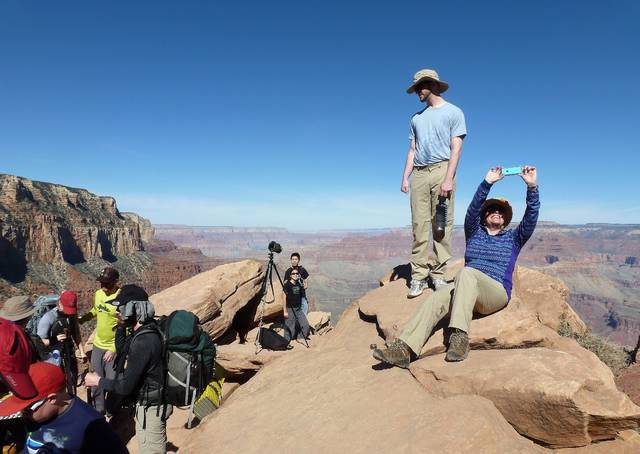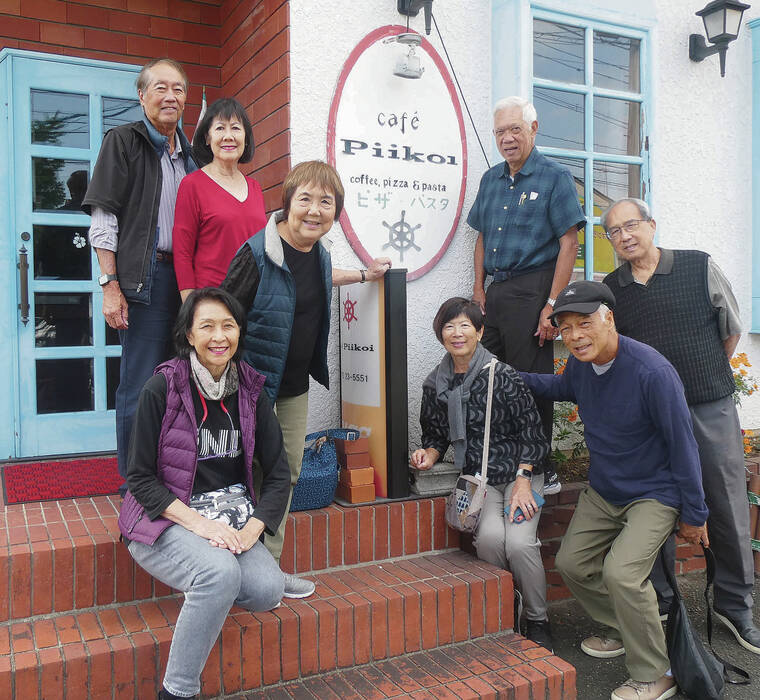7 ways to save on your next national park trip

ASSOCIATED PRESS
Hikers stop and take photos along the Grand Canyon National Park’s South Kaibab trail. With diverse landscapes and abundant wildlife, America’s national parks are popular travel destinations. To save money on a trip, break out the camping gear and schedule your visit around a fee-free day or during off-peak time.
America’s national parks are brimming with natural wonders: cascading waterfalls, towering redwoods, white sand beaches. But visiting these gems can cost money and soon will get a little pricier: Many parks will increase entrance fees by $5 June 1. Here are seven ways to plan a cheaper trip:
1. Travel off-peak
Mikah Meyer, 32, wants to become the youngest person to visit all 417 National Park Service sites. The Nebraska native has crossed more than 300 off the list.
He’s just one of the 330 million people who visited the national park system in 2017. Rooms and campsites fill up fast during weekends, spring break and summer. Meyer suggests visiting offseason to save money and avoid crowds.
Research seasonal conditions to prevent surprises, and note that some destinations have atypical high seasons. Warm-weather parks such as Death Valley and Everglades are busiest in winter.
2. Visit for free
Don't miss out on what's happening!
Stay in touch with breaking news, as it happens, conveniently in your email inbox. It's FREE!
More than two-thirds of national parks are free year-round. At the rest, entrance fees are waived on certain dates. The remaining fee-free days in 2018 are: National Public Lands Day (Sept. 22) and Veterans Day (Nov. 11).
3. Look for discounts
An annual pass to all parks costs $80, $20 for seniors or free for U.S. military members and fourth-grade students. Lifetime passes are free for those with permanent disabilities. Also, ask about discounts offered by wholesale clubs, frequent-flyer programs and memberships, such as AAA.
4. Skip the expensive lodge
Backcountry campsites, which are generally in remote areas accessible only on foot, are usually cheaper than developed campsites, says Kathy Kupper, public affairs specialist for the National Park Service. Campsites at Glacier National Park cost a maximum of $23 per night during peak season, for example, compared with the hundreds of dollars a night you might pay to stay in a lodge.
To avoid camping fees outright, Meyer camps free in U.S. Forest Service and Bureau of Land Management areas near national parks.
“Sometimes they have actual campsites with running water and bathrooms, and other times it’s just wherever you can fit your car, there you go,” Meyer says.
If roughing it doesn’t appeal to you, try hotels in gateway communities. Neighboring towns typically have more rooms and are less expensive than park lodges.
5. Buy supplies beforehand
Don’t wait until you’re near or inside the park to stock up on food, gas and other essentials.
“The closer you get to these places, especially when they’re out in the wilderness, there’s going to be that convenience charge,” Meyer says. “Something you might buy for $3 at your local grocery store could be $7 or $8 in the middle of nowhere.”
6. Explore your backyard
Every state has at least one national park, so you don’t have to spend a lot of money to travel to one. “It’s not always saving up for that once-in-a-lifetime trip to the Grand Canyon. You can go for a day or a weekend to a park near you,” Kupper says.
7. Look for free activities
Programs at parks, with few exceptions, are free, Kupper says. That includes activities like ranger-led hikes, snowshoe walks and kayak tours.
You can book tours on the National Park Service website. Once in the park, stop by a visitor center for more information.
“Spending time in nature is good for body and soul,” Kupper says. Doing it cheaply can be good for your wallet, too.




